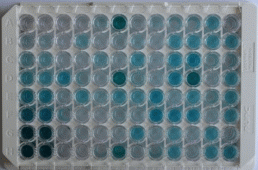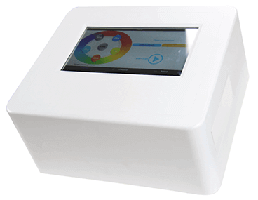Packages (Simulation)

Reagent Preparation

Image (I)
Image (II)
Certificate


Mini Samples ELISA Kit for Tumor Necrosis Factor Receptor 1 (TNFR1)
CD120A; P55; TNFRSF1A; TBP1; FPF; TNF-R; TNF-R-I; TNF-R55; TNFAR; TNFR55; TNFR60; P55-R; P60; Tumor necrosis factor receptor 1; Tumor necrosis factor-binding protein 1
- Product No.MEB499Hu
- Organism SpeciesHomo sapiens (Human) Same name, Different species.
- Sample Typeserum, plasma, urine, cell lysates and other biological fluids
- Test MethodDouble-antibody Sandwich
- Assay Length3h
- Detection Range15.6-1,000pg/mL
- SensitivityThe minimum detectable dose of this kit is typically less than 5.6pg/mL.
- DownloadInstruction Manual
- UOM 48T96T 96T*5 96T*10 96T*100
- FOB
US$ 375
US$ 535
US$ 2408
US$ 4548
US$ 37450
For more details, please contact local distributors!
Specificity
This assay has high sensitivity and excellent specificity for detection of Mini Samples Tumor Necrosis Factor Receptor 1 (TNFR1).
No significant cross-reactivity or interference between Mini Samples Tumor Necrosis Factor Receptor 1 (TNFR1) and analogues was observed.
Recovery
Matrices listed below were spiked with certain level of recombinant Mini Samples Tumor Necrosis Factor Receptor 1 (TNFR1) and the recovery rates were calculated by comparing the measured value to the expected amount of Mini Samples Tumor Necrosis Factor Receptor 1 (TNFR1) in samples.
| Matrix | Recovery range (%) | Average(%) |
| serum(n=5) | 93-104 | 99 |
| EDTA plasma(n=5) | 95-103 | 99 |
| heparin plasma(n=5) | 86-101 | 92 |
Precision
Intra-assay Precision (Precision within an assay): 3 samples with low, middle and high level Mini Samples Tumor Necrosis Factor Receptor 1 (TNFR1) were tested 20 times on one plate, respectively.
Inter-assay Precision (Precision between assays): 3 samples with low, middle and high level Mini Samples Tumor Necrosis Factor Receptor 1 (TNFR1) were tested on 3 different plates, 8 replicates in each plate.
CV(%) = SD/meanX100
Intra-Assay: CV<10%
Inter-Assay: CV<12%
Linearity
The linearity of the kit was assayed by testing samples spiked with appropriate concentration of Mini Samples Tumor Necrosis Factor Receptor 1 (TNFR1) and their serial dilutions. The results were demonstrated by the percentage of calculated concentration to the expected.
| Sample | 1:2 | 1:4 | 1:8 | 1:16 |
| serum(n=5) | 83-104% | 99-105% | 89-97% | 80-104% |
| EDTA plasma(n=5) | 93-101% | 91-104% | 85-92% | 79-96% |
| heparin plasma(n=5) | 91-102% | 93-105% | 78-105% | 81-97% |
Stability
The stability of kit is determined by the loss rate of activity. The loss rate of this kit is less than 5% within the expiration date under appropriate storage condition.
To minimize extra influence on the performance, operation procedures and lab conditions, especially room temperature, air humidity, incubator temperature should be strictly controlled. It is also strongly suggested that the whole assay is performed by the same operator from the beginning to the end.
Reagents and materials provided
| Reagents | Quantity | Reagents | Quantity |
| Pre-coated, ready to use 96-well strip plate | 1 | Plate sealer for 96 wells | 4 |
| Standard | 2 | Standard Diluent | 1×20mL |
| Detection Reagent A | 1×60µL | Assay Diluent A | 1×6mL |
| Detection Reagent B | 1×60µL | Assay Diluent B | 1×6mL |
| TMB Substrate | 1×4.5mL | Stop Solution | 1×3mL |
| Wash Buffer (30 × concentrate) | 1×10mL | Instruction manual | 1 |
Assay procedure summary
1. Prepare all reagents, samples and standards;
2. Add 25µL standard or sample to each well. Incubate 1 hour at 37°C;
3. Aspirate and add 25µL prepared Detection Reagent A. Incubate 1 hour at 37°C;
4. Aspirate and wash 3 times;
5. Add 25µL prepared Detection Reagent B. Incubate 30 minutes at 37°C;
6. Aspirate and wash 5 times;
7. Add 25µL Substrate Solution. Incubate 10-20 minutes at 37°C;
8. Add 20µL Stop Solution. Read at 450nm immediately.
GIVEAWAYS
INCREMENT SERVICES
| Magazine | Citations |
| PLoS ONE | A Combinatorial Relative Mass Value Evaluation of Endogenous Bioactive Proteins in Three-Dimensional Cultured Nucleus Pulposus Cells of Herniated Intervertebral Discs: Identification of Potential Target Proteins for Gene Therapeutic Approaches Plosone: Source |
| Mediators of Inflammation | High Glucose Level Disturbs the Resveratrol-Evoked Curtailment of CX3CL1/CX3CR1 Signaling in Human Placental Circulation pubmed:28655972 |
| Annals of Neurology | High complement levels in astrocyte‐derived exosomes of Alzheimer disease Pubmed:29406582 |
| International Journal of Immunopathology and Pharmacology | VEGF-R2 and TNF-R1 expression and cytokine production by samples of mammary adenocarcinomas and correlations with histopathological parameters of these … Pubmed:29985074 |
| Cell Death & Disease | Inhibition of transmembrane TNF-α shedding by a specific antibody protects against septic shock Pubmed: 31383857 |
| Journal of Cardiovascular Translational Research | XPO1 Gene Therapy Attenuates Cardiac Dysfunction in Rats with Chronic Induced Myocardial Infarction Pubmed: 31768947 |
| Frontiers in Pharmacology | M10, a Myricetin-3-ObD-Lactose Sodium Salt, Prevents Ulcerative Colitis Through Inhibiting Necroptosis in Mice Pubmed: 33041798 |













